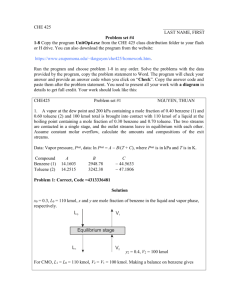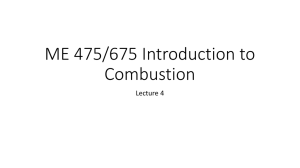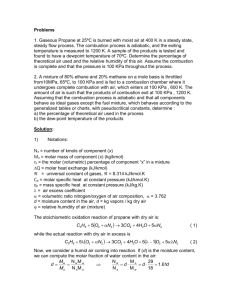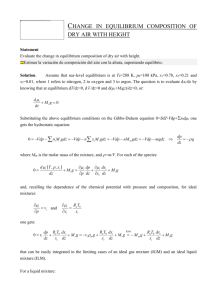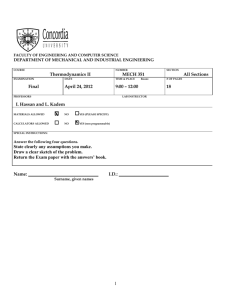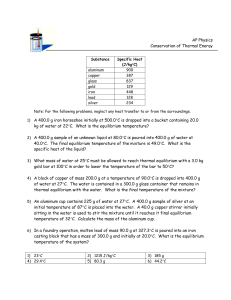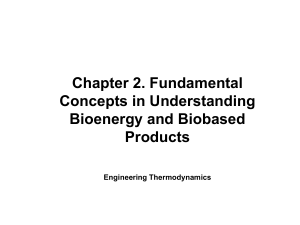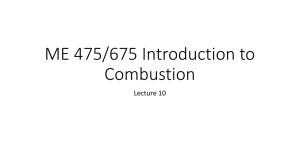ME470Chemical&PhaseEqHWSol
advertisement
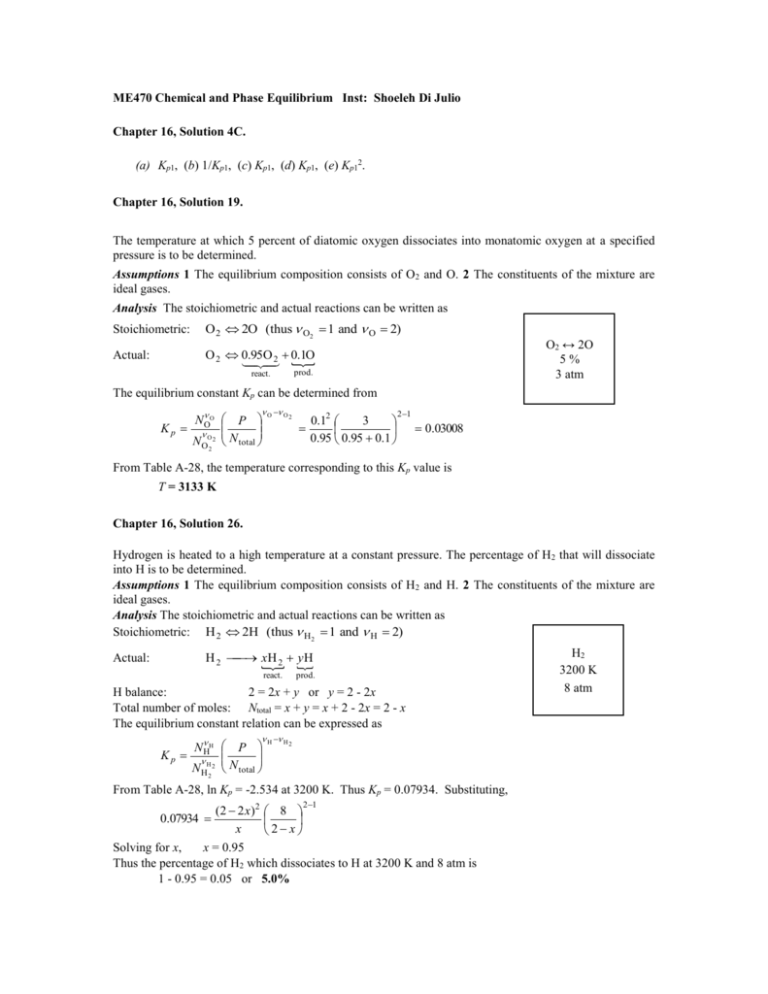
ME470 Chemical and Phase Equilibrium Inst: Shoeleh Di Julio Chapter 16, Solution 4C. (a) Kp1, (b) 1/Kp1, (c) Kp1, (d) Kp1, (e) Kp12. Chapter 16, Solution 19. The temperature at which 5 percent of diatomic oxygen dissociates into monatomic oxygen at a specified pressure is to be determined. Assumptions 1 The equilibrium composition consists of O2 and O. 2 The constituents of the mixture are ideal gases. Analysis The stoichiometric and actual reactions can be written as Stoichiometric: O 2 2O (thus O2 1 and O 2) Actual: O 2 0.95O 2 0 .1O react. O2 ↔ 2O 5% 3 atm prod. The equilibrium constant Kp can be determined from O O 2 N O P K p O N OO 2 N total 2 0.12 3 0.95 0.95 0.1 2 1 0.03008 From Table A-28, the temperature corresponding to this Kp value is T = 3133 K Chapter 16, Solution 26. Hydrogen is heated to a high temperature at a constant pressure. The percentage of H2 that will dissociate into H is to be determined. Assumptions 1 The equilibrium composition consists of H2 and H. 2 The constituents of the mixture are ideal gases. Analysis The stoichiometric and actual reactions can be written as Stoichiometric: H 2 2H (thus H2 1 and H 2) Actual: H2 xH 2 yH react. prod. H balance: 2 = 2x + y or y = 2 - 2x Total number of moles: Ntotal = x + y = x + 2 - 2x = 2 - x The equilibrium constant relation can be expressed as H H 2 N H P K p H N HH 2 N total 2 From Table A-28, ln Kp = -2.534 at 3200 K. Thus Kp = 0.07934. Substituting, (2 2 x) 2 0.07934 x 8 2 x 2 1 Solving for x, x = 0.95 Thus the percentage of H2 which dissociates to H at 3200 K and 8 atm is 1 - 0.95 = 0.05 or 5.0% H2 3200 K 8 atm Chapter 16, Solution 32. Liquid propane enters a combustion chamber. The equilibrium composition of product gases and the rate of heat transfer from the combustion chamber are to be determined. Assumptions 1 The equilibrium composition consists of CO2, H2O, CO, N2, and O2. 2 The constituents of the mixture are ideal gases. Analysis (a) Considering 1 kmol of C3H8, the stoichiometric combustion equation can be written as C 3 H 8 () a th (O 2 3.76 N 2 ) 3CO 2 4H 2 O + 3.76 a th N 2 C3H8 where ath is the stoichiometric coefficient and is determined from the O2 balance, 25C 2.5ath 3 2 1.5ath ath 5 Air Then the actual combustion equation with 150% excess air and some CO in the products can be written as C3H8 ( ) 12.5( O2 376 . N2 ) Combustion chamber 2 atm CO 1200 K CO2 H2O O2 N2 12C xCO2 (3 x )CO + (9 0.5x )O2 4H2O + 47N 2 After combustion, there will be no C3 H8 present in the combustion chamber, and H2O will act like an inert gas. The equilibrium equation among CO2, CO, and O2 can be expressed as CO 2 CO + 12 O 2 (thus CO 2 1, CO 1, and O2 12 ) and CO N CO N OO 2 P ( CO O 2 CO2 ) 2 Kp N CO2 total N CO 2 where N total x (3 x ) (9 0.5x ) 4 47 63 0.5x From Table A-28, ln K p 17 .871 at 1200 K. Thus K p 1.73 10 8 . Substituting, 1.73 10 8 (3 x)(9 0.5x) 0.5 x 1.51 2 63 0 . 5 x Solving for x, x 2.9999999 3.0 Therefore, the amount CO in the product gases is negligible, and it can be disregarded with no loss in accuracy. Then the combustion equation and the equilibrium composition can be expressed as C3 H 8 () 12.5(O 2 3.76N 2 ) 3CO 2 7.5O 2 4H 2 O + 47N 2 and 3CO 2 7.5O 2 4H 2O +47N 2 (b) The heat transfer for this combustion process is determined from the steady-flow energy balance Ein Eout Esystem on the combustion chamber with W = 0, Qout N h P f h h N h P R f h h R Assuming the air and the combustion products to be ideal gases, we have h = h(T). From the tables, (The h f of liquid propane is obtained by adding the hfg at 25°C to h f of gaseous propane). h f kJ/kmol -118,910 0 0 -241,820 -393,520 Substance C3H8 () O2 N2 H2O (g) CO2 h 285 K h 298 K h1200 K kJ/kmol --8696.5 8286.5 ----- kJ/kmol --8682 8669 9904 9364 kJ/kmol --38,447 36,777 44,380 53,848 Substituting, Qout 3( 393,520 53,848 9364) 4( 241,820 44,380 9904) 7.5( 0 38,447 8682) 47( 0 36,777 8669) 1( 118,910 h298 h298 ) 12.5( 0 8296.5 8682) 47( 0 8186.5 8669) 185,764 kJ / kmol of C3H 8 or Qout 185,764 kJ / kmol of C3H8 The mass flow rate of C3H8 can be expressed in terms of the mole numbers as m 12 . kg / min N 0.02727 kmol / min M 44 kg / kmol Thus the rate of heat transfer is Q out N Qout (0.02727 kmol/min)(185,746kJ/kmol) 5066 kJ/min N 2 12 O 2 NO is ln Kp = -7.569, which is very small. This indicates that the amount of NO formed during this process will be very small, and can be disregarded. The equilibrium constant for the reaction 1 2 Chapter 16, Solution 39C. The number of Kp relations needed to determine the equilibrium composition of a reacting mixture is equal to the difference between the number of species present in the equilibrium mixture and the number of elements. Chapter 16, Solution 40. Two chemical reactions are occurring in a mixture. The equilibrium composition at a specified temperature is to be determined. Assumptions 1 The equilibrium composition consists of H2O, OH, O2, and H2. 2 The constituents of the mixture are ideal gases. H2O, OH Analysis The reaction equation during this process can be expressed as H 2O x H 2O y H2 z O2 + w OH Mass balances for hydrogen and oxygen yield H balance: (1) 2 2x 2 y w H2O O2 , H 2 3400 K 1 atm O balance: (2) 1 x 2z w The mass balances provide us with only two equations with four unknowns, and thus we need to have two more equations (to be obtained from the Kp relations) to determine the equilibrium composition of the mixture. They are H 2 O H 2 12 O 2 (reaction 1) H 2 O 12 H 2 OH (reaction 2) The equilibrium constant for these two reactions at 3400 K are determined from Table A-28 to be ln K P1 1891 . K P1 015092 . ln K P2 1576 . K P2 0.20680 The Kp relations for these two simultaneous reactions are K P1 N HH 2 N OO 2 P ( H 2 O 2 H 2O ) 2 2 N H 2O total NH O and K P2 2 where ( ) OH N HH 2 N OH P H 2 OH H 2O 2 N HH O2O N total 2 N total N H2O N H2 NO2 NOH x y z w Substituting, ( y)( z )1 / 2 0.15092 x 1/ 2 1 x y z w (3) 1/ 2 1 (4) x y z w Solving Eqs. (1), (2), (3), and (4) simultaneously for the four unknowns x, y, z, and w yields x = 0.574 y = 0.308 z = 0.095 w = 0.236 Therefore, the equilibrium composition becomes 0.574H 2O 0.308H 2 0.095O 2 0.236OH 0.20680 ( w)( y)1/ 2 x Chapter 16, Solution 54. The hR value for the dissociation process O2 2O at a specified temperature is to be determined using enthalpy and KP data. Assumptions Both the reactants and products are ideal gases. Analysis (a) The dissociation equation of O2 can be expressed as O 2 2O The hR of the dissociation process of O2 at 3100 K is the amount of energy absorbed or released as one kmol of O2 dissociates in a steady-flow combustion chamber at a temperature of 3100 K, and can be determined from hR N h P f h h N h P R f h h R Assuming the O2 and O to be ideal gases, we have h = h (T). From the tables, Substance O O2 hf kJ/kmol 249,190 0 h 298 K h 2900 K kJ/kmol 6852 8682 kJ/kmol 65,520 110,784 Substituting, hR 2(249 ,190 65,520 6852 ) 1(0 110 ,784 8682 ) 513,614 kJ/kmol (b) The hR value at 3100 K can be estimated by using KP values at 3000 K and 3200 K (the closest two temperatures to 3100 K for which KP data are available) from Table A-28, ln K P 2 hR 1 h 1 1 1 or ln K P 2 ln K P1 R K P1 Ru T1 T2 Ru T1 T2 3.072 (4.357 ) hR 1 1 8.314 kJ/kmol K 3000 K 3200 K hR 512,808 kJ/kmol Chapter 16, Solution 66. A liquid-vapor mixture of ammonia and water in equilibrium at a specified temperature is considered. The composition of the liquid phase is given. The composition of the vapor phase is to be determined. Assumptions The mixture is ideal and thus Raoult’s law is applicable. Properties At 25C, Psat,H2O 3.170 kPa and Psat,NH3 1003.5 kPa . Analysis The vapor pressures are PH 2O y f ,H 2O Psat,H 2O (T ) 0.50 (3.170 kPa) 1.585 kPa PNH3 y f , NH3 Psat,NH3 (T ) 0.50 (1003 .5 kPa) 501 .74 kPa Thus the total pressure of the mixture is Ptotal PH2O PNH3 (1.585 501.74) kPa 503.33 kPa Then the mole fractions in the vapor phase become y g ,H 2O y g , NH3 PH 2O Ptotal PNH3 Ptotal 1.585 kPa 0.0031 or 0.31% 503.33 kPa 501 .74 kPa 0.9969 or 99.69% 503.33 kPa H2O + NH3 25C

